Semianalytic Solution of Space-Time Fractional Diffusion Equation
Abstract
We study the space-time fractional diffusion equation with spatial Riesz-Feller fractional derivative and Caputo fractional time derivative. The continuation of the solution of this fractional equation to the solution of the corresponding integer order equation is proved. The series solution of this problem is obtained via the optimal homotopy analysis method (OHAM). Numerical simulations are presented to validate the method and to show the effect of changing the fractional derivative parameters on the solution behavior.
1. Introduction
Fractional derivatives have been utilized for describing numerous models in different branches of applied science. Anomalous diffusion is one process that has been successfully modeled by fractional derivatives. This type of diffusion is characterized by the nonlinear dependence of the mean square displacement x(t) of a diffusing particle over time t: x2(t) ∝ kαtα, and it can be interpreted as the Lévy stable densities. On the other hand, in the case of classical diffusion, linear dependence x2(t) ∝ kt occurs and it follows Gaussian statistics and Fick’s second law for running processes at time t [1].
Anomalous diffusion is described by fractional partial differential equations (FPDEs) by replacing classical derivatives with derivatives of fractional order. A type of anomalous diffusion that received great attention is the fractional diffusion equation with spatial Riesz and Riesz-Feller fractional derivatives [2, 3]. These fractional derivative operators are used to model phenomena as anomalous diffusion [1], discrete random walk models [3, 4], and continuous random walk models [5] in the form of FPDEs.
General solutions are obtained for some classes of linear FPDEs, using integral transforms. For example, in [6], a general solution is given for a time fractional diffusion-wave equation defined in a bounded space domain. The fractional time derivative is described in the Caputo sense. The finite sine Laplace transform technique is used to obtain the solution. In [7], analytic techniques are introduced to solve certain types of multiterm time-space Caputo-Riesz fractional advection-diffusion equations on a finite domain using the equivalent relationship between the Laplacian operator and the Riesz fractional derivative. In [8], a fundamental solution is investigated for the space-time fractional diffusion-wave equation, which is obtained from the standard diffusion equation by replacing the second-order space derivative with a Riesz-Feller derivative and the first-order time derivative with a Caputo derivative. The paper [9] presents a solution of a unified reaction-diffusion equation with the Riemann-Liouville fractional derivative as the time derivative and Riesz-Feller derivative as the space derivative in terms of H-function. In [10], a closed form solution in terms of Mittag-Leffler function is obtained for a space-time fractional telegraph equation with Riesz-Feller derivative as the space derivative. In [11], a solution of a space-time fractional advection-dispersion equation is derived in terms of the Green functions.
The proposed abovementioned methods work in case of linear FPDEs. However, for the nonlinear case, the numerical methods and the semianalytic approaches have the advantage. Several numerical techniques are introduced in the literature, and we state some of the known methods here. In [12], the matrix transform method with the method of lines is used to obtain the numerical solution of a fractional partial differential equation with Riesz space fractional derivatives on a finite domain. An explicit finite-difference approximation is used to solve the variable-order nonlinear space fractional diffusion equation [13]. Crank-Nicolson method for the fractional diffusion equation with the Riesz fractional derivative is used in [14], while the improved matrix transform method with Pade approximation is used in [15]. Yet, semianalytic solutions for this type of problems include only the series solution by the variational iteration method approach (see [16, 17]) and by the homotopy analysis method (HAM) (see, e.g., [2, 18]). In [19], the homotopy analysis method with the Fourier transform is used to obtain and analytically approximate solutions of Riesz fractional diffusion equation and Riesz fractional advection-dispersion equation.
This paper is organized as follows. In Section 2, basic definitions of fractional derivative operators involved are presented. Proof of solution continuation is presented in Section 3. The OHAM is illustrated in Section 4. The results of numerical experiments are presented in Section 5. Section 6 contains the conclusion of this work.
2. Fractional Derivatives and Integrals
Definition 1. A real function f(x), x > 0, is said to be in the space Cμ, , if there exists a real number p > μ, such that f(x) = xpf1(x), where f1(x) ∈ C(0, ∞), and it is said to be in the space if fm ∈ Cμ,
Definition 2. The Riemann-Liouville fractional integral operator of order α ≥ 0 of a function f(x) ∈ Cμ, μ ≥ −1, is defined as
- (1)
JαJβf(x) = Jα+βf(x),
- (2)
JαJβf(x) = JβJαf(x),
- (3)
Jαxγ = (Γ(γ + 1)/Γ(γ + α + 1))xα+γ.
Definition 3. The fractional derivative in Caputo sense of , , x > 0, is defined as
Some basic properties of Caputo fractional derivative are listed in the following lemma.
Lemma 4. If m − 1 < α ≤ m, , and , μ ≥ −1, then,
Definition 5. The Riesz-Feller partial fractional derivative is defined as [3]
3. Optimal Homotopy Analysis Method (OHAM)
4. Continuation of the Solution
In this section, we define Riesz-Feller fractional derivative on unbounded domain in Caputo sense. This definition is considered as a generalization of the definition given in [27] for Riesz fractional derivative on bounded domains.
Definition 6. The Riesz-Feller fractional derivative in Caputo sense is defined by
Lemma 7. Let f(x) belong to the class of “good functions” [28]. Then, for α ∈ (0,2), α ≠ 1,
Proof. Consider the case α ∈ (0,1). Riesz-Feller fractional derivative can be written in the following form:
As the equivalence between the Riemann and Caputo definitions of Riesz-Feller fractional derivative is deduced, we discuss the continuation of the solution obtained.
Theorem 8. If f(x) is a function in L1(−∞, ∞), then the exact solution of the space-time fractional diffusion equation (1) is given by
Theorem 9. Let α ∈ (1,2), β ∈ (0,1), |θ| ≤ min (α, 2 − α), and f(x) be a function in L1(−∞, ∞), and let be solution (32) of the space-time fractional problem (1); then,
Proof. Consider the set of functions:
Similar arguments hold to prove the continuation of the solution when both parameters α and β tend to their integer limits.
5. Numerical Simulation
In this section, we consider linear and nonlinear problems to illustrate the efficiency of the OHAM to this type of problems and to illustrate the continuation of the solution we proved in Section 4. Yet, to apply the recursive technique of OHAM to problem (1), a repeated evaluation of Riesz-Feller fractional derivative to solution components is needed. This is accomplished by using a property of Riesz-Feller fractional derivative that is proved in the following lemma.
Lemma 10. Let α ∈ (0,2), α ≠ 1, |θ| ≤ min (α, 2 − α), and ω > 0. Then,
Proof.
Case α ∈ (0,1). From the definition of Riesz-Feller fractional derivative and by substitution, we can write
Case α ∈ (1,2). Consider
Example 11. Consider problem (1) with k(u) = 1, g(u) = au, and f(x) = ϵsin (πx/L):
The series solution is given by u = u0 + u1 + u2 + u3 + ⋯. Figure 1 shows the effect of the skewness parameter θ on the behavior of the solution. The plot represents the sum of the first five terms (u0 to u4) in the OHAM series when a = 1.0, ϵ = 1.0, L = 3.0, t = 0.2, and 0 < x < π and the fractional parameters β = 1.0, α = 1.5, and θ = 0,0.5, −0.5. At these different values of θ = 0,0.5, and −0.5, the optimal convergence-control parameter ħ is calculated as ħ = −0.995787, −1.049435, and −1.056491, and the corresponding residual error is obtained as E = 2.969688∗10−7, 4.243949∗10−6, and 4.453205∗10−6, respectively.
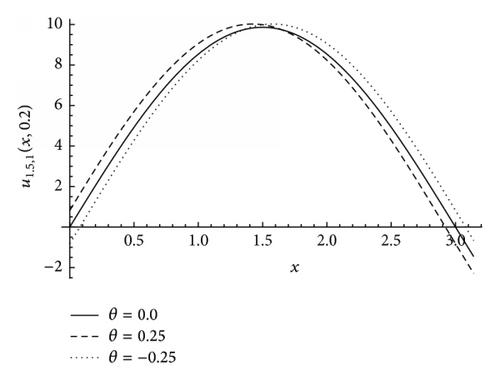
The solution (the first five terms in the OHAM series) behavior as the parameters θ, α, and β change at a fixed time t = 5.0 and in the interval 0 ≤ x ≤ π is shown in Figures 1–3. The amplitude of the solution decreases α and/or β increases. As α reaches 2 and/or β increases up to unity, the series solution approximately coincides with the exact solution of the corresponding integer order equation , represented by the solid line in the graph (refer to Figures 2 and 3), and this numerical result supports the continuation of the solution. The series displayed in plots is the partial sum of the first five terms: n = 5 (summing u0 to u4). The optimal convergence parameter ħ in each case is obtained by minimizing the residual error Em displayed in (23) in the intervals 0 ≤ x ≤ π and 0 ≤ t ≤ 6.0, and the obtained results are shown in Table 1.
| α, θ, β | Optimal ħ | Residual error (E4) | |
|---|---|---|---|
| α = 1.5, β = 1.0 | θ = 0.0 | −0.990381137 | 4.6032E − 10 |
| θ = 0.25 | −1.001711905 | 2.5426E − 5 | |
| θ = −0.25 | −1.0023206958 | 2.54262E − 6 | |
| β = 1.0, θ = 0 | α = 1.8 | −0.9339901124 | 2.2375E − 7 |
| α = 1.9 | −0.9303835167 | 3.4254E − 7 | |
| α = 1.95 | −0.9285827510 | 4.2025E − 7 | |
| α = 2.0, θ = 0 | β = 0.5 | −0.9099205063 | 9.7340E − 9 |
| β = 0.7 | −0.9151677201 | 7.4716E − 8 | |
| β = 0.9 | −0.9225579219 | 3.0301E − 8 | |
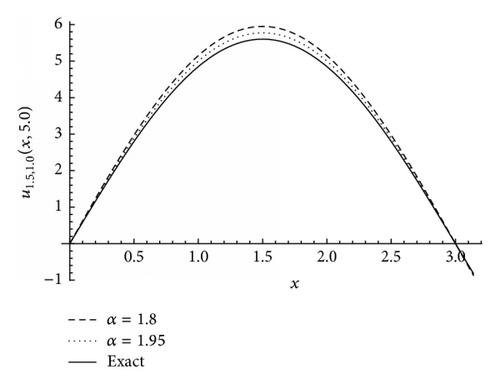

Example 12. Consider the nonlinear fractional problem (1) with k(u) = u, g(u) = 4u2 − u, and f(x) = sin (2x):
Figures 4–6 show the solution (the first five terms in the OHAM series) behavior as the parameters θ, α, and β change at a fixed time t = 0.2 and in the interval 0 ≤ x ≤ π/2. As α and/or β increases, the amplitude of the solution decreases. As α tends to 2 and/or β goes up to unity, the series solution approximately coincides with the exact solution of the corresponding integer order equation u = e−tsin(2x), represented by the solid line in the graph (see Figures 5 and 6), and this confirms the continuation of the solution numerically. The series displayed in plots is the partial sum of the first five terms: n = 5 (summing u0 to u4). The optimal convergence parameter ħ in each case is obtained by minimizing the residual error Em displayed in (23) in the intervals 0 ≤ x ≤ 2 and 0 ≤ t ≤ 0.4, and the obtained results are tabulated in Table 2.
| α, θ, β | Optimal ħ | Residual error (E4) | |
|---|---|---|---|
| α = 1.5, β = 1.0 | θ = 0.0 | −0.831733694 | 2.3498E − 8 |
| θ = 0.5 | −0.954364814 | 1.0016E − 5 | |
| θ = −0.5 | −0.637748947 | 7.4733E − 6 | |
| β = 1.0, θ = 0 | α = 1.92 | −0.589337116 | 2.3160E − 6 |
| α = 1.95 | −0.589337116 | 2.1595E − 6 | |
| α = 1.99 | −0.639152091 | 7.6926E − 6 | |
| α = 2.0, θ = 0 | β = 0.5 | −0.858637427 | 2.9308E − 9 |
| β = 0.7 | −0.929790675 | 7.6259E − 12 | |
| β = 0.95 | −0.973269800 | 2.7929E − 12 | |
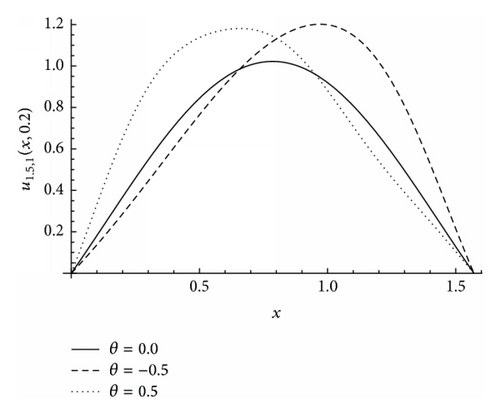
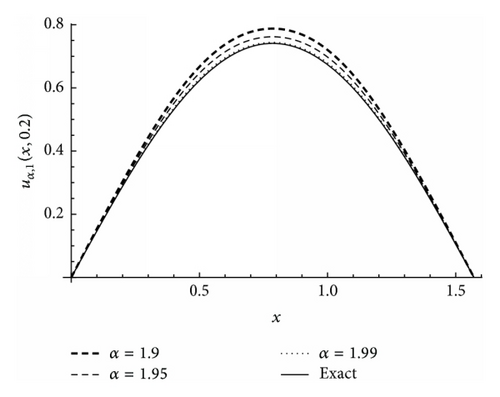
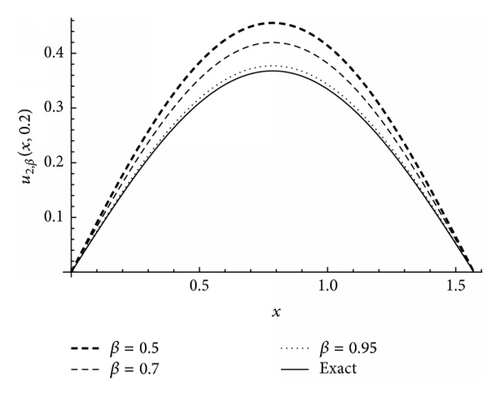
6. Conclusion
A definition of the fractional-order Riesz-Feller derivative in the Caputo sense is proposed and its equivalence with the classical definition is proved. Then, we proved the continuation of the solution of the fractional-order anomalous diffusion equation with Riesz-Feller spatial derivative to the corresponding Riesz problem. The iterative series solution for the fractional equation is obtained using the OHAM. The advantage of using this technique is the ability to estimate an approximation to the residual error. The results obtained illustrate graphically the continuation of the solution we proved theoretically.
Competing Interests
The authors declare that there is no conflict of interests regarding the publication of this paper.




